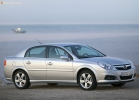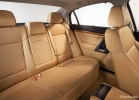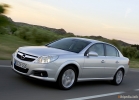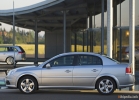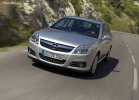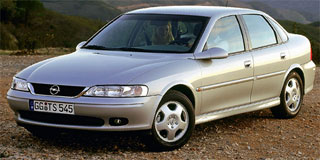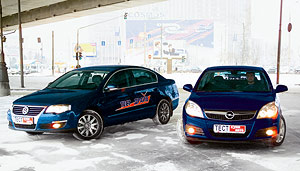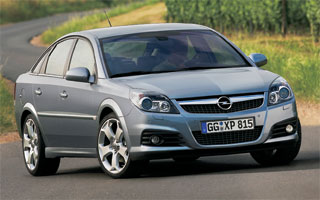Test drive Opel Vectra sedan 2005 - 2008 sedan
Universal in European
The official debut of automobile innovations in Russia is usually 5-10 months after the European premiere. So it happened this time. In the spring - in the summer of Russian dealers, three new universals of the middle class adapted to our conditions appeared on sale. All of them are in our test: Fiat Marea-UICEN ($ 24,500), Opel Vectra Caravan ($ 34,000) and Peugeot 406-break ($ \u200b\u200b20 576). Today, in the traffic flow on our roads, more and more universal foreign cars appear. What encourages a person who is able to lay out $ 20-30 thousand. On the purchase of a car, to opt for a sedan or compartment, but on a less prestigious utilitarian car? It can be a passion for traveling, the need to often transport voluminous sports equipment or another luggage, finally, just a pragmatic mindset. Let's see what it is - a modern European station wagon, comparing three new items.
Today, in the traffic flow on our roads, more and more universal foreign cars appear. What encourages a person who is able to lay out $ 20-30 thousand. On the purchase of a car, to opt for a sedan or compartment, but on a less prestigious utilitarian car? It can be a passion for traveling, the need to often transport voluminous sports equipment or another luggage, finally, just a pragmatic mindset. Let's see what it is - a modern European station wagon, comparing three new items. The nationality of the cars is most clearly expressed in their appearance: Fiat is Italian hot, expressive, which is emphasized by original design solutions, Opel - in German is restrained and functional, Peugeot - French is elegant. All station wagons are somewhat longer than the sedans, on the basis of which they are made, but in the 406th this is most noticeable-a break for a good quarter meter longer than colleagues-rivals.
Sixteen -valve engines of Fiat and Opel practically do not differ from those that are supplied to Europe. But Peugeot experts considered the optimal eight -valve engine with a reduced degree of compression more optimal for Russia. The suspension of all cars was finalized - the road clearance has been increased, and more rigid springs have greater energy intensity. At the fiat, a thin plastic screen will protect the motor compartment only from spray and dirt, on Opel a generous perforated steel sheet protects from stones and snags, and on a peugeot, an iron sheet will provide an engine and cleanliness and invulnerability without any holes.
The difference between powerful, long spar on Opel and Peugeot and two flat, half -meter lengths, overlays in the front of the bottom of the fiat is striking. Probably, this can be largely explained that when one rear wheel of the Italian is on a ten -centimeter tubercle, the body is overwhelmed and the doors are closed with a metallic knock.
 By the convenience of planting, the whole triple, you can set the assessment satisfactory. The weekend requires a lot of effort when closing the doors - you clap them like a truck. By the way, it is this car that will like more other distracted drivers: here the central castle will not work if one of the doors is loosely closed. In the caravan, the internal handles are forced to turn the brush to the stop. 'Break boasts large doorways, but this advantage is compensated by uncomfortable outer door handles, in the Muscovite-2140 style, and the lack of visible doors lock buttons from the outside.
By the convenience of planting, the whole triple, you can set the assessment satisfactory. The weekend requires a lot of effort when closing the doors - you clap them like a truck. By the way, it is this car that will like more other distracted drivers: here the central castle will not work if one of the doors is loosely closed. In the caravan, the internal handles are forced to turn the brush to the stop. 'Break boasts large doorways, but this advantage is compensated by uncomfortable outer door handles, in the Muscovite-2140 style, and the lack of visible doors lock buttons from the outside. The rear seat turned out to be the closest to Fiat: only two will be conveniently accommodated here. The width of the salon for the shoulders of three medium complexion men is already insufficient. True, the hump on the back squeezes the middle passenger from the general row forward and thereby makes it possible to turn his shoulders almost without interference. The heads of two extreme riders find themselves close to the fairly solid lighting plafones located on the racks. Opel's rear seat turned out to be unexpectedly spacious: significantly more space for the legs and a little wider in the shoulders. The three of us can be already quite comfortable, however, a hump on the back, although smaller, is also present here. The passengers of Peugeot are most lucky - his salon is the most spacious. In addition, the backs of the front seats are made with recesses, so that even in the extreme rear position, the knees of passengers of the second row do not rest in them. The rear seat resembles a soft sofa without pronounced seats - three people will be located here almost as conveniently as two. There was no central armrest on our 'Break from behind, but only he, unlike competitors, could boast of completely dropping rear windows.
 All cars are equipped with five head restraints. At the weekend, they do not interfere with the review, because they can fall off with the back, and when laying it down, there is no need to dismantle them. On the caravan, only the central head restraint of the second row is receded, the four others more with hardness and dimensions are more like a fist stubborn in the back of the head. The trump card of the head workers Break is their softness.
All cars are equipped with five head restraints. At the weekend, they do not interfere with the review, because they can fall off with the back, and when laying it down, there is no need to dismantle them. On the caravan, only the central head restraint of the second row is receded, the four others more with hardness and dimensions are more like a fist stubborn in the back of the head. The trump card of the head workers Break is their softness. The front passenger will feel quite comfortable in all three cars. A glove box on the Italian car of the most modest size. On German - narrow and deep, like a hole. It is convenient to open it only with the right hand, and the lid rests on the knees. The French has the most voluminous basket, and even locked on the castle.
The driver Peugeot will fit the seat quickly - there are only two familiar mechanical adjustments. The driver of Opel can, in addition, move the seat up and down, and the fiat also - also to change the lumbar backup - also manually. All chairs, including rather soft French, have good side support. Only on Opel is not provided for adjusting the height of the steering wheel. The gearbox lever is perhaps the 406th, but the handbrake was far from behind. On the Marea-UIKEND, the fourth gear and reverse move are too close, and the armrest interferes with the parking brake. Vectra has a blocking of random inclusion of reverse transmission: you need to raise a manet on the gearbox lever.
 The remaining governing bodies are quite traditional, and you immediately get used to them. The exception is perhaps only the overloaded right -wing steamed switch on the fiat is a tribute to the rich set of the machine, and the sound signal button, located on Peugeot traditionally in French - in the end of the left steering wheel switch. In addition, lighting technology does not quite familiarly work on these two cars: at the first, when the ignition is turned off, all external lighting goes out, including dimensions, on the second, with a similar operation, nothing goes out, even the highlight of the headlights. On Opel, only a rotating switch of the inner rear -view mirror, which requires more attention than the usual lever, is unusual. Review from each car has its own characteristics. Marea-UIKEnd does not see the edge of the hood and very massive racks. On the vector, the edge of the hood is clearly visible, the racks are less massive, but the outer mirrors resemble the petals not only in shape, but also in size. Viewing the surroundings from the 406th is perhaps the most convenient. Surprisingly - even three headrests of the second row almost do not interfere with watching back. The only remark is the thick rear racks of the body.
The remaining governing bodies are quite traditional, and you immediately get used to them. The exception is perhaps only the overloaded right -wing steamed switch on the fiat is a tribute to the rich set of the machine, and the sound signal button, located on Peugeot traditionally in French - in the end of the left steering wheel switch. In addition, lighting technology does not quite familiarly work on these two cars: at the first, when the ignition is turned off, all external lighting goes out, including dimensions, on the second, with a similar operation, nothing goes out, even the highlight of the headlights. On Opel, only a rotating switch of the inner rear -view mirror, which requires more attention than the usual lever, is unusual. Review from each car has its own characteristics. Marea-UIKEnd does not see the edge of the hood and very massive racks. On the vector, the edge of the hood is clearly visible, the racks are less massive, but the outer mirrors resemble the petals not only in shape, but also in size. Viewing the surroundings from the 406th is perhaps the most convenient. Surprisingly - even three headrests of the second row almost do not interfere with watching back. The only remark is the thick rear racks of the body.  A large convenient trunk is the beauty and pride of the station wagons. It is the most spacious - Peugeot Break, although there is only one transformation options, since the back of the rear seat on our car turned out to be whole. The resulting 1820 mm area allows you to comfortably accommodate here for the night.
A large convenient trunk is the beauty and pride of the station wagons. It is the most spacious - Peugeot Break, although there is only one transformation options, since the back of the rear seat on our car turned out to be whole. The resulting 1820 mm area allows you to comfortably accommodate here for the night. The suspensions located under the floor of the springs provided the Weekand with the largest space between the wheel arches - 1030 mm. The two -section door allows you to transport very long flat cargoes, protruding only to the lower part. The leaning regiment does not give significant advantages when loading and unloading moderately, since the loading height is almost the same for all three cars, but it takes more than the width of the shelf to the depths of the luggage compartment.
Opel-channel has a trunk of the most modest sizes, but has the widest in the upper part of the opening of the fifth door, which is very significant when transporting, say, a TV with a diagonal of a meter and above. There are plenty of transformation of the last two cars, since their rear seats are folded in a ratio of 40:60 (on the fiat, the narrow part is located on the left, and on Opel - on the right). In addition, in the niches of the central armrests there are hatches convenient for transportation, such as skis. Above all the trunk are covered with half -down regiments. Under the floor - niches with full -sized spare wheels, but mounted on simple iron discs. The tool is the most necessary: \u200b\u200ba jack, a wheel key, a removable towing eye, sometimes a screwdriver.
 Various power of the engines led to completely predicted differences in the dynamic qualities of cars. We add to this that Fiat has the most acute steering and a rigid suspension, which is sensitively responding to the quality of the road surface. Opel can boast of short and clear moves of the gearbox lever. Pejo has the softest suspension, which delicately carries the car through all the potholes. But the adhesion move is great, and some trembling is felt on the accelerator pedals. And the motor seems too loud, probably due to the lack of sound insulation on the inside of the hood.
Various power of the engines led to completely predicted differences in the dynamic qualities of cars. We add to this that Fiat has the most acute steering and a rigid suspension, which is sensitively responding to the quality of the road surface. Opel can boast of short and clear moves of the gearbox lever. Pejo has the softest suspension, which delicately carries the car through all the potholes. But the adhesion move is great, and some trembling is felt on the accelerator pedals. And the motor seems too loud, probably due to the lack of sound insulation on the inside of the hood. Fiat and Opel in European are demanding of the quality of gasoline-only an unhealthy 95th. Peugeot is more flexible and will be satisfied with the 92nd, even ethyled, since it does not have a catalytic neutralizer. For all three models, an annual warranty is given without limiting a run. It can be implemented in Russia, respectively, at seven, four and three maintenance stations, the norms of work on which costs $ 45, 36 and 43.
 The editors thanks the company Alfa-Romeo-Moscow, Autoimport and Armand-Pigio
The editors thanks the company Alfa-Romeo-Moscow, Autoimport and Armand-Pigio for the cars provided for the test.
Meet the novelty of the Russian station wagon market (from left to right): Opel Vectra-Karavan, Peugeot 406-Break, Fiat Marea-Uikend.
The appearance of Fiat is most avant -garde.
In the central part of the front panel there is a fiat radio of an original shape.
Over the interior, designers also worked on fame.
The 1.8-liter engine was considered optimal for Russia. An interesting feature: candles with individual ignition coils are hidden under an additional upper engine cover.
The appearance of Opel-karavan is typical for the station wagon.
The speedometer marked up to 260 km/h is clearly designed for a more powerful car.
The purity of doorways provides triple seal at the top and double - below.
To obtain a more even characteristic of torque, in all engines of the eco -tech series, intake collectors of alternating volume are used.
Who said that the station wagon cannot be elegant?
The front panel and instrument panel look too ascetic for a car of this class. In place of the tachometer - a big watch.
As if in contrast to the meter width of the upper part, below the opening of the rear door is very narrowed by a scallop around the wheel arch.
In front of a very tilted engine, quite a lot of empty space. The front spar corrugated in the bow provides with the average collision a crushing of this particular zone of the motor compartment, without prejudice to the power unit and front suspension.
Fiat Marea-UIKEND 1.8 16 V
 Technical characteristics of the car
Technical characteristics of the car General data: number of places - 5; Equipped mass - 1255 kg; full weight of 1850 kg; maximum speed - 193 km/h; acceleration time from a place to 100 km/h - 10.6 s; fuel consumption at 90.120 km/h and Hz - 6.0; 7.8; 10.1 l/100 km; fuel supply - 63 liters; Fuel - unhealthy gasoline AI -95. Size, mm: length - 4485; width - 1740; height - 1510; base - 2540; The track in front/back - 1480/1455, road clearance - 170; trunk volume - 500/1550 l; The turning radius is 5.4 m. Engine: a 16-valve 4-cylinder in a row, with two camshafts and distributed electronic injection, is located in front of the front; working volume - 1747 cm; cylinder diameter and piston stroke - 82.0 x 82.7 mm; compression degree - 10.3; Power - 83 kW/113 hp at 5800 rpm; The maximum torque is 154 N.M at 4400 rpm. Transmission: front wheel drive; gearbox - mechanical five -speed; Transporting numbers: I - 3.91; II - 2.24; III - 1.52; IV - 1.16; V - 0.95; Z.Kh. - 3.91; The main program is 3.56. Suspension: independent, with reptile stabilizers, collected on subframes; Front - like McExeson, the back is on single longitudinal levers. Brakes: hydraulic, with a vacuum amplifier and ABS; Front - ventilated disk, rear - drum. Steering: rheck with a hydraulic wrap. Tire size: 195/55R15

Five-door universal Fiat Marea-UICEN and FIAT-MAREA Four-door sedan debuted in July 1996, as the logical development of the Bravo / Brava presented by a year earlier with three- and five-door hatchbacks (ZR, 1996 No. 6.) Both cars can be equipped with gasoline 1.4 working volumes; 1.6; 1.8 and 2.9 liters or 1.9- and 2.4-liter turbodiesels. Gearboxes - a five -speed mechanical and four -speed automatic (only with a 1.6 l engine).
+ Original design, acute steering, good review back.
- Little hardness of the body for twisting, hard suspension, a tight salon behind.
Summary
Temperament car for active drive on good roads.
Opel Vectra-Karavan 2.0 16 V
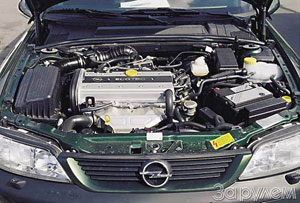 Technical characteristics of the car
Technical characteristics of the car General data: number of places - 5; equipped mass - 1320 kg; Full mass - 1910 kg; maximum speed - 207 km/h; acceleration time from a place to 100 km/h - 10.5 s; fuel consumption at 90.120 km/h and Hz - 6.1; 7.6; 10.0 l/100 km; fuel supply - 60 liters; Fuel is unhealthy gasoline AI -95. Dimensions, mm: length - 4490; width - 1710; height - 1450; base - 2640; The track in front/back - 1480/1470; Road clearance - 140; trunk volume - 460/1490 l; The turning radius is 5.7 m. Engine: a 16-valve 4-cylinder in row, with two camshafts and distributed electronic injection, is located in front of the front; working volume - 1998 cm; cylinder diameter and piston stroke - 86.0 x 86.0; compression degree - 9.2; Power - 100 kW/136 hp at 5600 rpm; The maximum torque is 188 N.M at 3200 rpm. Transmission: front wheel drive; gearbox - mechanical 5 -speed; Transporting numbers: I - 3.58; II - 1.88; III - 1.23; IV - 0.92; V - 0.74; Z.Kh - 3.33; The main program is 3.94. Suspension: independent, with stabilizers of the anti -resistance, collected on subframes, the front - such as McExeson, the back is three -leafed. Brakes: hydraulic, with a vacuum amplifier and ABS, disk, front - ventilated. Steering: rheck with a hydraulic wrap. Tire size: 195/65R15.
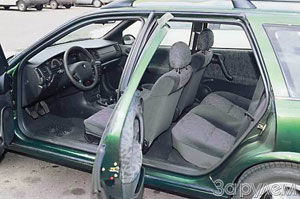
Universal Opel Vectra-Karavan was shown in August 1996, a year after the release of the new vector with bodies of sedan and hatchback. Engines - gasoline with a working volume of 1.6; 1.8; 2.0 and 2.5 liters or 1.7- and 2.0-liter turbodiesels. The gearboxes are a five -speed mechanical or four -speed automatic (except for machines with an eight -valve version of a 1.6 liter engine and diesel engines).
+ Wide opening of the fifth door, good dynamic qualities.
- High price, uncomfortable door handles, hard head restraints.
Summary
A successful compromise between respectability and practicality.
PEUGEOT 406-break 1.8
 Technical characteristics of the car
Technical characteristics of the car General Dannies: number of places - 5; equipped mass - 1310 kg; full weight - 1805 kg; maximum speed - 185 km/h; acceleration time from a place to 100 km/h - 12.5 s; fuel consumption at 90.120 km/h and Hz - 6.1; 7.6; 10.9 l/10o km; fuel supply - 70 liters; Fuel is AI -92 gasoline, let's say ethyled. Dimensions, mm: length - 4725; width - 1760; height - 1500; base - 2700; The track in front/back - 1500/1480, road clearance - 180; trunk volume - 525/1740 l; The turning radius is 6.0 m. Engine: an 8-valve 4-cylinder row, with distributed electronic injection, is located in front of the front; working volume - 1761 cm; cylinder diameter and piston stroke - 83.0 x 81.4; compression degree - 9.2; Power - 70 kW/97 hp at 6000 rpm; The maximum torque is 145 N.M at 3000 rpm. Transmission: front wheel drive; gearbox - mechanical five -speed; Transporting numbers: I - 3.46; II - 1.87; III - 1.36; IV - 1.05; V - 0.80; Z.Kh - 3.33; The main program is 4.16. Suspension: independent, with reptile stabilizers, collected on subframes; Front - like McExeson, the back is four -leaf. Brakes: hydraulic, with a vacuum amplifier, front - ventilated disk, rear - drum. Steering: rheck with a hydraulic wrap. Tire size: 195/65R15.

The PEUGEOT 406 universal was represented by the public in the fall of 1996, a little more than a year after the premiere of the new Peugeot 406 with a sedan body. On these machines, gasoline engines are installed with a working volume of 1.6 (except for the station wagon); 1.8; 2.0 and 2.9 liters or 1.9- and 2.1-liter turbodiesel. The gearboxes are a five-speed mechanical or four-speed automatic (only with atmospheric versions of 2.0 and 2.9-liter engines).
+ Low price, spacious interior, soft suspension, 92nd gasoline.
- A noisy motor, trembling on the accelerator pedals, an ascetic interior.
Summary
A lot of car for moderate money. Calm, spacious family car.



Yuri Nechetov
Photo by Vladimir Knyazev
Source: The magazine "Driving"

